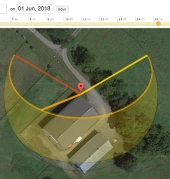
 4
4




 2
2








With attached sensors, it can actually smell where cows peed
...take from me the spirit of sloth, despair, lust of power, and idle talk




Idle dreamer




Tyler Ludens wrote:Maybe someone can explain how the robots fit into the design and ethical system of permaculture? How DO robots work in permaculture?
...take from me the spirit of sloth, despair, lust of power, and idle talk




Idle dreamer
 3
3




Idle dreamer





Tyler Ludens wrote:Here's a permaculture robot idea my husband came up with - a robotic imprinter which trundles along in degraded desolate lands, utilizing photovoltaic and GPS technology to imprint the land on contour for large-scale restoration where it would be very uncomfortable for humans to work. There are vast areas of degraded agricultural lands in the American Southwest where this kind of robot could come in very handy. The basic technology has already been invented and used elsewhere (like on Mars). It would only take construction and programming of the actual robots to get this show on the road. This robot would fit under the First Ethic: Care of the Earth. All components could be designed to be recyclable.
Article about imprinting: http://permaculturenews.org/2012/09/19/imprinting-soils-creating-instant-edge-for-large-scale-revegetation-of-barren-lands/





Idle dreamer

 2
2




Tyler Ludens wrote:My husband calls it a robot for terraforming Earth.





Idle dreamer

 1
1




Tyler Ludens wrote:He is deeply interested in this idea, and would love for it to come to fruition.
Adding a seed-scattering function would be boss! Especially if they are native seeds.




Idle dreamer












 2
2




Idle dreamer
 1
1




 2
2








Zach Muller wrote:Just for the record, where would humans need to drop seed balls via drone?
 2
2




 1
1




Idle dreamer




Zach Muller wrote:Just for the record, where would humans need to drop seed balls via drone?
I am going through inaccessible areas in my mind and dropping the seeds is not the particularly desirable or difficult aspect.
A seed ball shooter would probably be more fun and simple anyhow.
 5
5




 3
3





 1
1




 1
1








Jason Silberschneider wrote:Technology such as this is the norm on current day mine sites. Dump truck "drivers" sit in offices in Perth, each in control of several massive dump trucks on a minesite hundreds of kilometres away. Onboard radars will detect an obstacle the size of a cat, causing the truck to stop and send an alarm for onsite staff to attend and investigate. Of course, mine sites use this technology for the complete opposite goal of permaculture.





|
I guess everyone has an angle. Fine, what do you want? Just know that you cannot have this tiny ad:
Homestead Pigs Course
https://permies.com/wiki/365748/Homestead-Pigs
|







